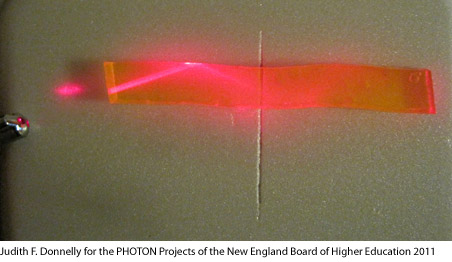Teachers' Domain - Digital Media for the Classroom and Professional Development
User: Preview
 Loading Standards
Loading StandardsOptical fibers transmit light signals and are widely used in the telecommunications industry to transmit data over long distances. Light travels through the core material of an optical fiber by essentially repeatedly bouncing off the cladding material that surrounds the core. Understanding refraction and how light behaves at the boundary of two different materials is the basis for understanding how fiber optic lines work. In particular, total internal reflection occurs when light travels in a material with a higher index of refraction toward a material with a lower index of refraction and the angle of incidence is greater than the critical angle.
In this lesson, students investigate through experimentation, discussion, and video the phenomenon of total internal reflection and its relationship to fiber optics. Students also watch a video about dispersion and discuss the implications for fiber optics.
Note: This is the second of two optics lesson plans. You may want to precede this lesson with The Index of Refraction Lesson Plan.
Computers with Internet connection
For each group:
1. Review with students what happens when light travels from a material with a higher index of refraction to a material with a lower index of refraction. In this case, the refracted angle is larger than the incident angle. Illustrate this situation with a drawing: show a small incident angle and a larger refracted angle. Ask students:
2. Have students explore the critical angle by cutting the gelatin slab to form a right triangle (or use a triangular plastic refraction shape). Direct the laser through one of the sides and watch the behavior of the beam as the angle of incidence changes at the hypotenuse edge. With plastic it should be easy to observe the change from refraction to total internal reflection at the critical angle. Unless the gelatin edge is very clean, the change to total internal reflection will not be as abrupt as it is with plastic.

3. Show students the Laser Waterfall Video. Ask students to explain how the concept of total internal reflection applies to optical fibers.
4. Have students investigate total internal reflection by cutting a thin strip from one of the gelatin slabs (about 2 cm wide and as long as possible). Ask students to direct the laser pointer so that the beam undergoes total internal reflection. Discuss with students:

5. Dispersion is the dependence of index of refraction upon wavelength. That is, the index of refraction is not the same for all colors of the spectrum. Show students the Light and Color Video. Discuss the following:
6. Even though fiber optic systems use LEDs or lasers instead of white light, there is still a (small) range of wavelengths present in the light. If some wavelengths travel faster they will reach the end of the fiber before the slower wavelengths. Draw a square input pulse and discuss with students what the pulse will look like if different wavelengths reach the end of the fiber at different times. A useful analogy is to think about the density of runners at the start of a marathon and at the finish line; a hundred runners may start at the same time as part of the same "pulse," but since each runner travels at a different rate, they will spread out over the course of the race and have different finishing times.

 Teachers' Domain is proud to be a Pathways portal to the National Science Digital Library.
Teachers' Domain is proud to be a Pathways portal to the National Science Digital Library.
